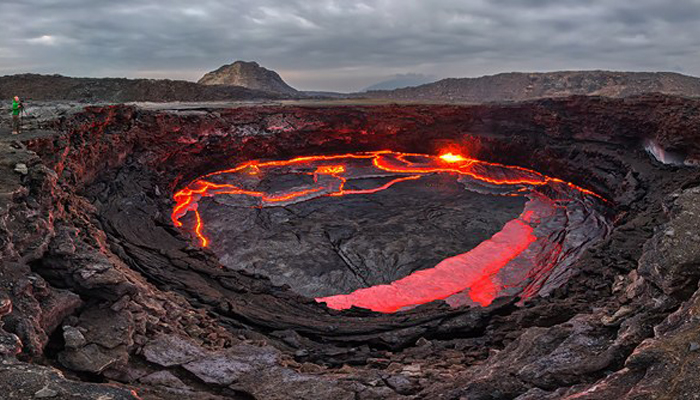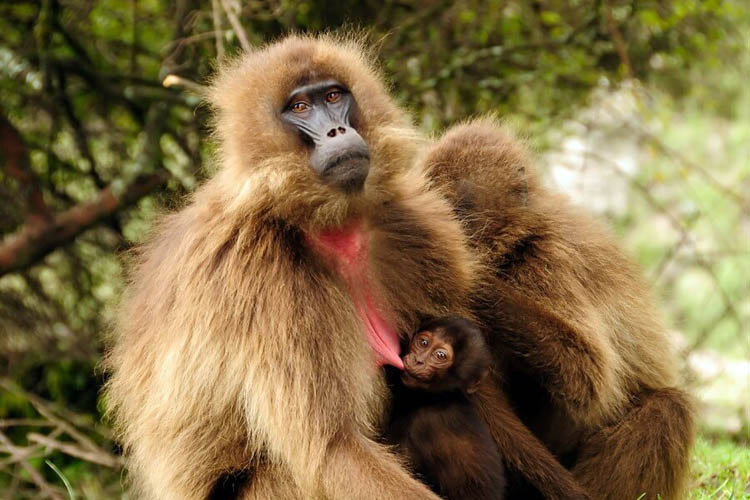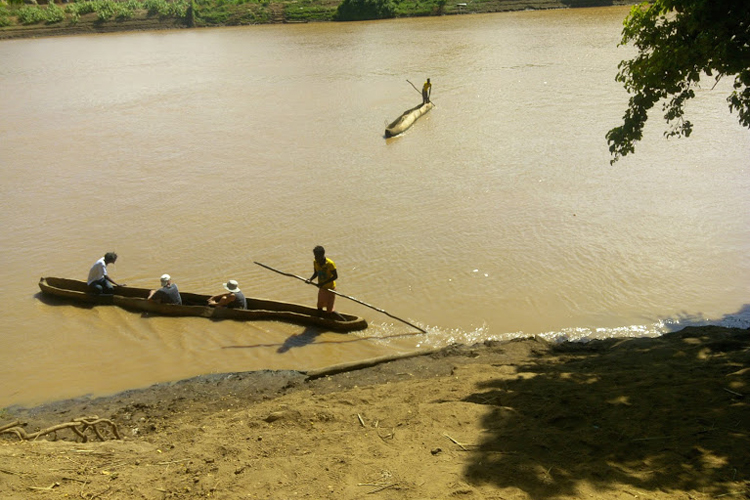Natural Attractions
Ethiopia is one of the best Country in the world for natural wonders. with a great geographical diversification which comprises high and rugged mountains, flat-topped plateaus, deep gorges, valleys and vast rolling plains dissected by rushing streams that are tributaries of famous rivers like the Abay (the Blue Nile). Its altitude ranges from the highest peak at Ras Dashen 4620m above sea level, down to the Dallol Depression, about 116m below sea level. The tropical climates, its physical conditions and variations in altitude have resulted in great diversity of terrain, climate, soil, flora and fauna.
SO, Ethiopia is one of the richest country in the world by its natural wonders in the four quadrants of the country. Accordingly, these natural attractions are listed down from the desert to the highlands as well as numerous wild life reserves (national parks) and numerous lakes too.
 The Danakil Depression :-lies at 136,956 km square (52,879 sq miles) of arid terrain close by Eritrea and Djibouti boarder which it has a complex geological history. The Danakil Depression is the hottest place on Earth in terms of the average temperature throughout the year.
The Danakil Depression :-lies at 136,956 km square (52,879 sq miles) of arid terrain close by Eritrea and Djibouti boarder which it has a complex geological history. The Danakil Depression is the hottest place on Earth in terms of the average temperature throughout the year.
Erta^ale is centered over the East African Rift system and situated at an elevation of 613m (2,011 ft) high, the longest-existing lava lake since maybe over hundreds of years. It occasionally overflows on the side of the volcano mountain. Volcanoes with lava lakes are very rare to find in the planet. So; Ethiopia is proudly promoting its natural beauty through us: http:/www.fikirethiopiatours.com
Ethiopian highlands & mountains:- Ethiopian mountains are known for their biodiversity. They also boast of spectacular beauty and Comprises a high plateau with tall, precipitous cliffs and chasmic river valleys. Semien Mountain, Balle Mountain and Abune-Josef Mountain are among the others, but these are famous and well-known by their chained and dramatic views of the rugged mountains.
Simien Mountain:- The home of mount Ras-Dashen, which is the highest peak country that raised up to the elevation of 4,620m above sea level. As well as Mount Ancua, and Mount Bwahit, is a part of other peaked mountains among the rugged mass of mountains found in the park. Park is seated at a wide coverage of 412km square
Balle Mountain:- Which hosts Mount Tullu Dimtu, is waiting to be declared a world heritage site? (2,150 square kilometers) The park’s Afromontane habitats have one of the highest incidences of animal Endemicity of any terrestrial habitat in the world including the Ethiopian wolf.
Abune Josef Mountain:- Situated at an altitude of 4,280m within a natural grace of its breathtaking views of the chained mountains structure, Water rivers and gorges. Ethiopian third-highest mountain abune-yosef is covered some 72 k.m square. Its biodiversity is very tangible by its avifauna including the endemic wildlife such as, Ethiopian wolfs, gelada baboons, a few furtive leopards, and isolated hamadryas baboons. As well as a typical highland birds such as lammergeier and others.
National parks
 Gambella National Park:-is a 4,575-square-kilometre (1,766 sq mi) national park in Ethiopia, near the South Sudanese border. It is the nation’s largest national park. Gambella is located 800 kilometers from Addis Ababa, Gambella National Park has one of the highest concentrations of wildlife in Ethiopia, 69 mammal species occur in the protected area including African elephant, African buffalo, White-eared kob bushpig, common warthog, giraffe, hippopotamus,kéwel, Nile lechwe, sable, tiang, topi, and waterbuck, cheetah, leopard, lion, mantled guereza, olive baboon, patas monkey, andspotted hyena. And including more than 320 bird species.
Gambella National Park:-is a 4,575-square-kilometre (1,766 sq mi) national park in Ethiopia, near the South Sudanese border. It is the nation’s largest national park. Gambella is located 800 kilometers from Addis Ababa, Gambella National Park has one of the highest concentrations of wildlife in Ethiopia, 69 mammal species occur in the protected area including African elephant, African buffalo, White-eared kob bushpig, common warthog, giraffe, hippopotamus,kéwel, Nile lechwe, sable, tiang, topi, and waterbuck, cheetah, leopard, lion, mantled guereza, olive baboon, patas monkey, andspotted hyena. And including more than 320 bird species.
Nechisar National ParkL:- found in the southern Ethiopia. This park is a good eco-logical conservatory for different fauna and floras. It Is found between two lakes Abay and Chamo lake.
Awash National Park:- this park is 225 kilometers east of Addis Ababa, with its southern boundary along the Awash River, and covers 756 square kilometers of acacia woodland and grassland. The park in Awash River gorge has amazing waterfalls. In the upper Kudu Valley at Filwoha is hot springs amid groves of palm trees.
Mago National Park:-is the National Parks located in the Southern Ethiopia about 782 kilometers from Addis Ababa.bend in the Omo River, the 2162 square kilometers of this park are divided by the Mago River, which a tributary of the Omo river.
Lakes
 Lake tana:- the Lake was nominated as a UNESCO Biosphere Reserve recognizing its national and international natural and cultural importance. This is first largest lake in Ethiopia by a size approximately 2,500km square. This is the source of river Nile which is Long Distance Running River finish its journey at victoria. 37 islands on the lake, monasteries and churches are built on the 18 islands.
Lake tana:- the Lake was nominated as a UNESCO Biosphere Reserve recognizing its national and international natural and cultural importance. This is first largest lake in Ethiopia by a size approximately 2,500km square. This is the source of river Nile which is Long Distance Running River finish its journey at victoria. 37 islands on the lake, monasteries and churches are built on the 18 islands.
Lake chamo:- is found in Arba Minch in southern Ethiopia. The lake is surrounded by a popular park called Nech sar. Several wildlife come to the shore for their daily water need. The lake is a home for different fishes and water animals including catfish Bagrus docmak and Nile perch, as well as hippopotamus and Nile crocodiles.
Lake abijata & shala:- 200 kilometers (124 miles) away south of Addis Ababa. Naturally itself situated at an amazing spectacular volcanic gorge and surrounded by foggy hills. This is very important lakes for aquatic bird life, particularly those that feed and breed on lakes in large numbers. Seasonal migratory birds are often available to be seen here.
Lake langano:- The brown lake which is best known place for the weekend outside Addis Ababa, comfortable and recreational place for tourist including the domestic weekenders. Birders often come to this place for overnight. The same 200km south of Addis Ababa.
Bishoftu lakes:- (debre zeit) 40 km FROM ADDIS Bishoftu is rich in 7 (seven) creator lakes & there is one different man-made lake which have beautiful scenery. Almost all the lakes give attractive scenic beautiful surrounding rocky steep invites for sightseeing and nature admiring. Domestic and international tourist chooses this place for weekends.
Sof-omar cave:- Formed by the Web River as it changed its course in the distant past and carved a new channel through limestone foothills, the Sof-Omar system is an extraordinary natural phenomenon of breathtaking beauty.
120 kilometers (74 miles) far from Balle , through a low valley filled with thorn trees and weird funnels of termite hills, and you’ll come across one of the most spectacular and extensive underground caverns in the world: the Sof Omar cave system.
Here, the Web River vanishes into this giant underground world with its arched portals, high eroded ceilings, and deep, vaulted echoing chambers. These caves, now an important Islamic shrine named after the saintly Sheikh Sof Omar, who took refuge here many centuries ago, have a religious history that predates the arrival of the Muslims in Bale – a history calibrated in thousands, not hundreds, of years.
The first religions of this part of Africa revolved around spirit worship and ghost cults in which the most powerful super¬natural beings were believed to attach themselves to trees, rocks, and, most forcefully, to caves, which became places of veneration where prayers were offered up and sacrifices made. Even today, the visitor to Sof Omar will see many signs of the persistence of such pagan beliefs and practices.
Birds in Ethiopia
Ethiopia is situated in the north-eastern horn of Africa, equidistant between the equator and the tropic of Capricorn. its avifauna is one of the richest in Africa. Ethiopia is becoming one of Africa’s most wanted country for birding adventure. Birders worldwide are becoming aware of the unique bird list of Ethiopia.
The bird species of Ethiopia are mix of African, Palearctic and a fantastic number of endemic species makes Ethiopia a poplar and recognized country for birding adventure around the world. More than 920 species of birds, some 590 are resident species wile 220 species are seasonal migrants, 76 of which are Palearctic migrants. 31 species are of global conservation concern needing special protection measures. The other 26+ Species are endemic to Ethiopia.
It is also very possible that further species await discovery in the forests and parks of the country.( the wing of an apparently endemic species of night jar was discovered as recently as 1992 in Nech-sar National Park, and the live bird was first seen in 2009) “bradt guide” truly a birding country.
 As much as possible the selected places for birding will be inserted in to the tour date or itinerary. Whatever most of this birds are will be visible at most probable confidence at selected bird sanctuaries.
As much as possible the selected places for birding will be inserted in to the tour date or itinerary. Whatever most of this birds are will be visible at most probable confidence at selected bird sanctuaries.
1 Awash national park
2 Abijata-shala national park
3 Wondo genet
4 Arba minch & lake chamo
5 Mago & omo national park
6 Yabello park
7 Gambela national park.
8 Balle mountain n.p.
9 Debre libanos
10 Lake tana and its island .
11 Nile river
12 Semien mountain
13- Shire park
14 Abune yosef mountain
15 Ziway, bishoftu, langano lakes (rift valley lakes)
16 Ambo & woliso
